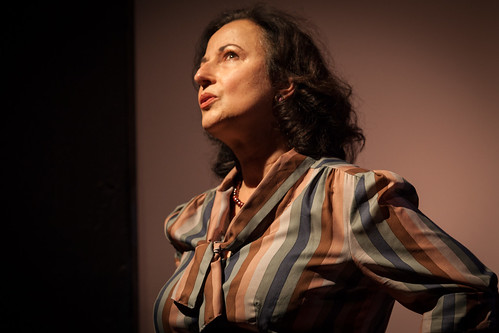Sublime stories from Word for Word and Alice Munro
 Jeri Lynn Cohen is a homemaker who wants an office of her own in which to write in Word for Word's Stories by Alice Munro: "The Office" & "Dolly." Below: Howard Swain and Sheila Balter are a couple addressing the end of their lives and dealing with their past in "Dolly." Photos by Mark Leialoha
Jeri Lynn Cohen is a homemaker who wants an office of her own in which to write in Word for Word's Stories by Alice Munro: "The Office" & "Dolly." Below: Howard Swain and Sheila Balter are a couple addressing the end of their lives and dealing with their past in "Dolly." Photos by Mark Leialoha
Any celebration of Alice Munro merits attention, but when that celebration comes from Word for Word, the ever-astonishing local company that transforms short fiction into brilliant theater with complete fidelity to the original text, attention must not only be paid but also reveled in and savored.
Word for Word brought a Munro story to life in 1999 ("Friend of My Youth"), and the intervening years have brought more acclaim for the Canadian writer and a Nobel Prize for literature. Now that she is rightly revered for her masterful prose, Munro is given a full Word for Word evening in Stories by Alice Munro: "The Office" & "Dolly," a sort of career bookend with one story from her first collection, Dance of the Happy Shades (1968) and her most recent, Dear Life (2012). What's clear is that Munro started out with a gift for clarity, precision and astonishing insight, and that gift only intensified with time.
The first story, "The Office," feels somewhat autobiographical as Munro's protagonist is a homemaker who also writes but is embarrassed to call herself a writer. What she really wants is an office, a writing space of her own. A man's work outside the home has its traditional, respected place in society, but a woman's place, the home, is ruled by children, and the though of a mother removing herself from them behind a closed door is perceived as unacceptable. So this mother, this wife, this writer (Jeri Lynn Cohen), heads downtown to find herself a room of her own.
She finds the perfect spot, formerly occupied by a chiropractor, and quickly sets up her minimal furnishings – table, typewriter, hotplate, kettle, instant coffee and mug. Her separate, simplified space turns out to be too good to be true. There's a man, the landlord (Paul Finocchiaro), who feels no compunction about invading her space and squandering her time. He refuses to accept that she doesn't want a touch of color in the room – a rug, new paint, a plant, a plush chair because women want those kinds of things – and turns himself into a nuisance.
There are likely many actors who could convey the flustered frustration and inner turmoil of the protagonist, but I can't imagine anyone better than Cohen, who manages to be heartfelt and funny and misanthropic all while conveying a desperate need to create in solitude. This is a woman operating on multiple levels. There's the polite citizen attempting to navigate home life and an attempted professional life, and then there's the sharp, enraged, wildly intelligent woman inside reacting to everything around her. Our view of this woman is so thorough (through Munro's prose and Cohen's superb performance) that humor is abundant and laughs are hearty.
And that's an amazing thing to me. I've read most of Munro's work and relished it, but I don't recall laughing out loud often. But in both "The Office" and "Dolly," the second story, the humor is deeply satisfying and quite audibly appreciated by the audience. It's a laughter of recognition, and that's always the best kind.
Both of these stories deal with the inner lives of smart, complex women dealing with seemingly ordinary problems, but Munro can take us deeper in the space of a sentence. There's also a link between the stories when it comes to writing. In "The Office" the woman can't quite own up to being a writer. And in "Dolly," a man, a horse trader by profession, also works as a published poet. But for him, too, writing is a little shady. When you're working with horses, you're obviously, he says. But when you're working on a poem, you just look idle.
There's a woman writer in "Dolly" as well. After a career in the classroom, she has taken to writing books rescuing certain Canadian writers from obscurity. The teacher/writer (Sheila Balter) and the poet (Howard Swain) are in their later years. He's in his early 80s, she's about a decade younger, and they casually but efficiently discuss the details of their joint suicide. But then life, in the from of an old flame named Dolly (Susan Harloe) shows them they're not quite as tapped out as they thought.
As in the first story, the actors here, under the expert direction of Joel Mullenix, revel in the kind of humor that not only elicits laughs but also deepens our connections to the characters. Balter is especially good at conveying the emotional turmoil of a woman who is surprised to find herself in the kind of upheaval she would have never expected at this stage in her life. And Harloe and Swain convey the power of a years-old connection with a mix of joy and confusion and, ultimately, nonchalance.
This set of stories delivers exactly what we've come to expect from both Munro and Word for Word: brilliant prose and beguiling theatricality. It's the perfect combination.
[bonus interview]I wrote a cover story for the San Francisco Chronicle's 96 Hours section on Word for Word's Stories by Alice Munro: "The Office" & "Dolly". Read the feature here.
FOR MORE INFORMATIONWord for Word's Stories by Alice Munro: "The Office" & "Dolly" continues through April 12 at Z Below, 470 Florida St., San Francisco. Tickets are $35-$55. Call 866-811-4111 or visit www.zspace.org.
